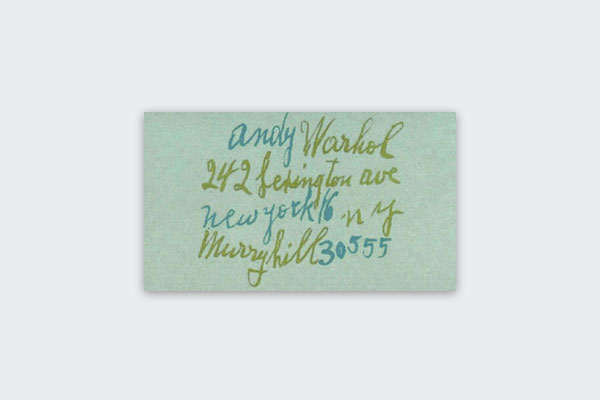Family Business (ENG), 2016
in Oracles artist calling cards,
ed. Pierre Leguillon, jrp ringier
in Oracles artist calling cards,
ed. Pierre Leguillon, jrp ringier

Before tackling ads, Campbell’s soup cans, dollar bills, car crashes and Coca-Cola bottles, Warhol worked for nearly ten years as a commercial illustrator. His drawings for Vogue, Glamour, Harper’s Bazaar and the New Yorker display a remarkable finesse and delicate lines, far from the Pop Art brutality of his first silk screens. And yet some Warholian principles were already in place. The pointillism of Warhol the illustrator was the result of the play of tracing and stamps, which enabled him to produce several copies of a single drawing. He was also in the habit of inviting friends to work on commissioned jobs. The handwriting on his business cards, for instance, is by the artist’s mother, Julia Warhola, who came to live with him at 242 Lexington Avenue, three blocks east of the Empire State Building on 34 th Street. Warhol habitually used her loopy, uneven handwriting for his commercial work, making it a sort of signature lettering. In 1958, Julia even received an award for a Moondog album cover designed by Warhol and executed by her. The artist’s assistants would reproduce this distinctive hand for other orders, sometimes using Letraset letters based on her script. In enlisting his immediate entourage, Warhol was already experimenting in a “preindustrial” form with the production methods of his future Factory, a “family” enterprise.
Conversely, the repetitive approach of Warhol the artist was not just a mechanical gesture, it was also an echo of everyday activities : going shopping and cooking dinner, going to the office and working, even praying. Repetition is a form of ritual, and it was this ritual that the artist turned into a business. The subject of his work was not only consumer society, but activities repeated so many times they lose any meaning. In the 1980s, Warhol’s diary entries retain traces of this daily repetition in a veritable litany of parties, orders, telephone calls and taxi receipts, to which was added a running list of those in his entourage who died each week of Aids. Warhol mentions attending a party for Bret Easton Ellis in 1986, when the 22-year-old writer had just published his debut novel, Less Than Zero.
There is no record of whether the two men exchanged business cards, but Ellis was taking notes at the time for American Psycho, a novel haunted by repetition and in a style eerily close to that of Warhol’s Diaries. Ellis wrote it in an apartment in the East Village. “The first time I set foot in my apartment,” the novelist says in a Vanity Fair interview, “the funeral service for Andy Warhol was taking place in St. Patrick’s Cathedral. It was April Fools’ Day, which is also the day American Psycho starts.” A kind of writing was handed from one artist to the other, like a business card – and with it a smuggled legacy of business, death and work, work, work…